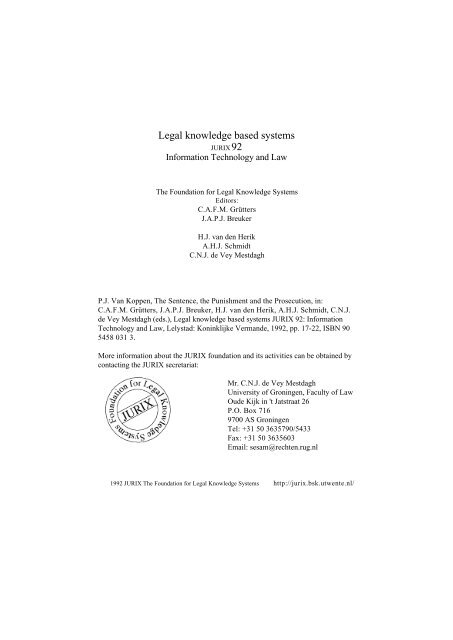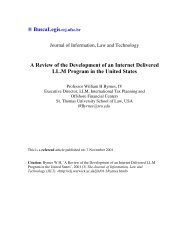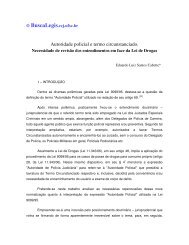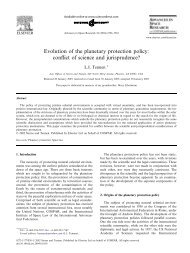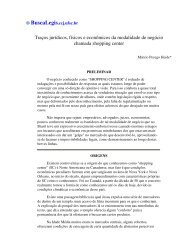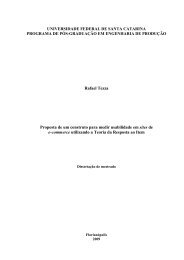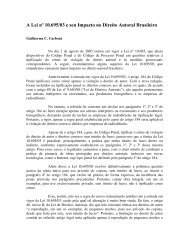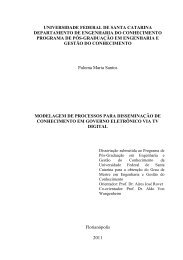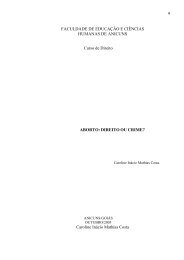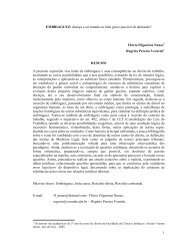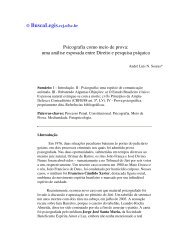Legal knowledge based systems - CiteSeerX
Legal knowledge based systems - CiteSeerX
Legal knowledge based systems - CiteSeerX
Create successful ePaper yourself
Turn your PDF publications into a flip-book with our unique Google optimized e-Paper software.
<strong>Legal</strong> <strong>knowledge</strong> <strong>based</strong> <strong>systems</strong><br />
JURIX 92<br />
Information Technology and Law<br />
The Foundation for <strong>Legal</strong> Knowledge Systems<br />
Editors:<br />
C.A.F.M. Grütters<br />
J.A.P.J. Breuker<br />
H.J. van den Herik<br />
A.H.J. Schmidt<br />
C.N.J. de Vey Mestdagh<br />
P.J. Van Koppen, The Sentence, the Punishment and the Prosecution, in:<br />
C.A.F.M. Grütters, J.A.P.J. Breuker, H.J. van den Herik, A.H.J. Schmidt, C.N.J.<br />
de Vey Mestdagh (eds.), <strong>Legal</strong> <strong>knowledge</strong> <strong>based</strong> <strong>systems</strong> JURIX 92: Information<br />
Technology and Law, Lelystad: Koninklijke Vermande, 1992, pp. 17-22, ISBN 90<br />
5458 031 3.<br />
More information about the JURIX foundation and its activities can be obtained by<br />
contacting the JURIX secretariat:<br />
Mr. C.N.J. de Vey Mestdagh<br />
University of Groningen, Faculty of Law<br />
Oude Kijk in 't Jatstraat 26<br />
P.O. Box 716<br />
9700 AS Groningen<br />
Tel: +31 50 3635790/5433<br />
Fax: +31 50 3635603<br />
Email: sesam@rechten.rug.nl<br />
1992 JURIX The Foundation for <strong>Legal</strong> Knowledge Systems http://jurix.bsk.utwente.nl/
THE SENTENCE, THE PUNISHMENT AND THE PROSECUTION<br />
P.J. VAN KOPPEN<br />
Netherlands Institute for the Study of Criminality and Law Enforcement (NISCALE),<br />
Leiden, The Netherlands<br />
1. Introduction<br />
Any program aiming at reducing differences in sentencing by different judges for<br />
comparable crime is the right solution to the wrong problem. Such programs be it a<br />
special Court of Appeals for sentencing policy or any <strong>knowledge</strong> system to aid the judge<br />
are not related to what sentences do, namely punishing, and ignore how sentences come<br />
about. I will discuss both problems in turn and will finish with a possible solution.<br />
I need to make one remark in advance. I will concentrate on common crime committed by<br />
common offenders. These are the same types for which setting standards by a special<br />
Court of Appeals or by a <strong>knowledge</strong> <strong>based</strong> system has any sense. Probably, my remarks<br />
are less relevant for what I call special crimes, like exceptionally violent crimes or `onetime'<br />
crimes as husbands killing their wives.<br />
2. Sentencing versus punishment<br />
The focus on sentencing in both proposals starts from the assumption that the sentence is<br />
the punishment. It is not; at least not the major part of the punishment. Let us have a look<br />
at punishment, and return to sentencing later.<br />
Laboratory experiments in psychology – be it with rats, pigeons, or humans – has learned<br />
us much about punishment. In the history of psychology, research on learning has taken<br />
a large place. One type or learning is particularly relevant here: operant conditioning. This<br />
is, simply put, learning by the consequences of one's behaviour. Behaviour which is<br />
always or often followed by pain is suppressed; behaviour which is always or often<br />
followed by pleasure is reinforced. That is the general scheme used by nature and,<br />
indeed, by most parents, to educate and socialize human beings. If we touch a hot stove,<br />
we burn our fingers. Such learning is severe, but can go fast. Parent sometimes have<br />
more trouble – as I know from experience – in learning "good" behaviour by<br />
reprimanding their children. Reinforcing behaviour by rewarding children is, indeed,<br />
often easier.<br />
Research has learned us much on the conditions under which punishment works best and<br />
on the kinds of punishments which are most effective [Houten, 1983]. In summary<br />
[Crombag, 1992] punishment is most effective when it is immediate, inescapable, severe,<br />
and given on a fixed ratio schedule of 1, i.e., each time the forbidden behaviour occurs.<br />
Let us take a look in more detail. The benefits of immediate punishment has become<br />
common <strong>knowledge</strong> in the criminal justice system. In fact the policy for handling<br />
football-hooligans is aimed at inflicting immediate punishment upon them. For most<br />
crimes, however, the punishment is neither immediate nor escapable. But I will return to<br />
that later.<br />
Two items in the list of effective punishment are at odds with how we want to organize<br />
our state and our criminal justice system. Giving punishment on a fixed ratio schedule of<br />
1 is not related to sentencing, but to the likelihood of getting caught. To reach such a<br />
schedule, we would need to reach a likelihood which might only be attained in a police<br />
state. We have chosen a state in which a fixed ratio schedule of 1 would be impossible.<br />
17
Koppen, P.J. van<br />
Within certain limits, the same arguments hold for the severity of punishment. We know<br />
that the intensity of punishment is directly related to the amount of behaviour suppression:<br />
the higher the intensity, the more bad behaviour can be suppressed. Since we abolished<br />
the rack and other forms of torture, there is a limit to the intensity of punishment we can<br />
inflict, but intensity can be surplanted by a longer duration of punishment.<br />
This is not a plea for tough punishment, even for minor crimes. But at present we punish<br />
offenders completely the other way around. The common pattern encountered by the<br />
common offender is the following. After the first offence he is caught for, he is usually<br />
only reprimanded especially when he starts his criminal career at an early age. With<br />
successive occasions, the punishment grows gradually, until he finally is sentenced to a<br />
prison term. From psychological research we know this is probably almost the best way<br />
to learn offenders that crime pays. Low-intensity punishment produces a characteristics<br />
pattern of recovery of the suppressed behaviour and, more important, successive<br />
punishment is much less effective. With this pattern of punishment we learn the<br />
perpetrator that crime pays: at first the financial and emotional gain from the crime is not<br />
compensated by any real punishment; later on the slow increase of punishment intensity is<br />
compensated by habituation to punishment by the offender.<br />
The relatively most effective scheme would be to punish from the start. From<br />
psychological perspective there is ample reasons to punish the first offender, not by<br />
reprimanding him, but with a punishment which surpasses any gains from the crime.<br />
There is no reason to inflict inhumane or extreme punishment for minor crimes, but there<br />
is enough reason to give the same punishment to each and every offender for a particular<br />
crime.<br />
This would also make punishment less escapable as it is now. Most offenders are not<br />
caught, but if caught, there a numerous ways to evade a sentence, and if sentenced, there<br />
a numerous ways to evade a decent sentence. Fixed sentences for fixed crimes if proven<br />
of course would give offenders less opportunity to escape a useful sentence.<br />
3. Criminal careers<br />
Let me now turn to a more general perspective on how criminals learn. The following<br />
has, I admit, a more speculative basis but may be enlightening for the problem at hand.<br />
A typical relation between crime rate and age is depicted in Figure 1. Starting at young<br />
age, say somewhere between 12 and 15 years, the crime rate starts going up, reaches its<br />
height at the age of about 20 and decreases to a relatively low rate at somewhere around<br />
30. This graph is quite typical across countries and across time [Gottfredson & Hirschi,<br />
1990, pp. 130 ff].<br />
There have been many criminological theories which tried to explain the rise of this graph;<br />
there have been some trying to explain the decline of crime at later age. None has been<br />
successful in explaining both the rise and fall of crime during the maturation of offenders.<br />
Looking at this graph from a learning perspective might give such an explanation, though<br />
I must warn you that there is little empirical support for the contentions I am going to<br />
make.<br />
In general the graph indicates that teenagers from 12 years onward but probably from an<br />
earlier age learn that crime pays; that the net profit of the pleasures of crime and the pains<br />
of punishment is positive. From the age of twenty many of them learn that crime does not<br />
pay until somewhere around 30 most have learned this; for some crimes continues to pay<br />
until old age. If this view is right, we changed the problem to: How do offenders learn<br />
their crime pays and how do they start to learn after a certain age – apparently from blue<br />
sky – that it does not pay?<br />
18
Crime<br />
Rate<br />
The Sentence, the Punishment and the Prosecution<br />
Age<br />
Figure 1: Age distribution of crime<br />
Taking this point of view, some obvious hypotheses follow.<br />
1. At young age, the profits of crime surpass the pain suffered from punishment. We<br />
know that the criminal justice system only plays a minor role in this scheme of<br />
punishment: only 8 to 10 percent of the time juvenile offenders are caught for the<br />
common crimes they reported themselves [Junger-Tas et al., 1992], or less than 30<br />
percent of the crimes reported to the police are resolved [TK, 1990-1991]. Then, it<br />
seems obvious that, at that age, crime pays.<br />
2. During maturation offenders seem to give up crime more and more, learning that<br />
crime does not pay. The kick they get out of crime might become less. With<br />
experience they may find out that most criminal acts are indeed – as Gottfredson<br />
and Hirschi hypothesized – "trivial and mundane affairs that result in little loss [for<br />
the victim] and less gain. These are events whose temporal and spatial distributions<br />
are highly predictable, that require little preparation, leave few lasting<br />
consequences, and often do not produce the result intended by the offender"<br />
[Gottfredson & Hirschi, 1990, p.16]. A fair hypothesis would be that the<br />
contingencies of the average offender's environment learns him to abandon crime<br />
[Cusson & Pinsonneault, 1986]; they learn that other things in life give a larger and<br />
more lasting kick and an ordinary job produces more profits. For, again, the rate at<br />
which offenses are reported to the police and the rate at which offenders are caught<br />
cannot explain the decline in crime rate [Beck & Hoffman, 1976].<br />
There may be one exception: at this age recidivists are punished harder if caught. If<br />
this punishment has any effect, there is, again, no reason why we did not start<br />
doing that at an earlier age.<br />
3. To make my hypotheses complete, but of little relevance to the sentencing problem<br />
at hand: After 30 a relatively small proportion of the population remains criminally<br />
active. These may consists of two kinds of individuals: those who did not learn<br />
anything in the past and will not in the future and the clever ones, who found a<br />
manner of committing crime which, against all odds, pays.<br />
4. Making sentencing pay<br />
19
Koppen, P.J. van<br />
If my analysis above proves right, and if sentencing has such a little impact on criminal<br />
behaviour, our sentencing policy seems to be wrong. Introducing a sentencing scheme<br />
that has an effect might have some very nasty side-effects. Setting punishment on a ratio<br />
of 1 would require a police state; and even then it might be a hopeless task. But even if<br />
we cannot reach such a state of affairs, it might be fruitful to try to get as near to it as<br />
possible. That would involve fixed sentences for each crime which is habitual for the<br />
average offender. Thus, the punishment need not be extremely severe, but becomes<br />
relatively inescapable and, most important, certain if caught. Doing that for special crimes<br />
– husbands who kill their wives, for instance, or the other way around, wives who kill<br />
their husbands – does not serve any purpose. But letting the shoplifter know in advance<br />
that getting caught and proven guilty automatically means, say, a week imprisonment or a<br />
ƒ 300 fine can be expected to have a larger preventive effect than the present practice.<br />
In The Netherlands the sentence is not only related to the crime, but also related to<br />
characteristics of the suspect, because the punishment, among others, serves the purpose<br />
of changing the behaviour of the accused. Following my analysis would mean that<br />
varying the punishment from offender to offender, from first offenders to recidivists, and<br />
from court to court, then, in fact means that the punishments is less effective than is<br />
possible. This is a paradox: whether the hand is lenient or tough, any hand sensitive to<br />
the offender produces less effect than an unsensitive hand.<br />
Effective sentencing would involve fixed sentences for each crime imposed on every<br />
offender, from first offender to the many time recidivist. I do not agree with the obvious<br />
objection that such would be inhumane punishment. If it would have the effect that first<br />
offenders are kept from crime more often than now – in other words that the crime graph<br />
smoothed out from the start – nothing seems more humane to me.<br />
The sentencing problem, then, is solved in a straightforward manner: we do not need a<br />
special Court of Appeals, nor a <strong>knowledge</strong> <strong>based</strong> system, but only a simple table with<br />
crimes and sentences.<br />
5. The role of the public prosecution<br />
Changing the perspective from what the offenders needs to the behaviour of the judge, I<br />
begin with a loose remark. In the '60 and '70 judicial behaviour was a fairly hot topic<br />
both in psychology and political science. From, as far as I know, the first study [Becker,<br />
1966] on Hawaiian judges, there was a great upsurge in studies of judicial decision<br />
making [Hogarth, 1971][Crombag et al., 1977][Van Duyne, 1980][Van Duyne, 1983]<br />
[Van Duyne, 1991][Van Duyne & Verwoerd, 1985][Van Duyne & Van Koppen, 1991]<br />
[Ten Kate & Van Koppen, 1984][Van Koppen & Ten Kate, 1984]. I will summarize the<br />
conclusions drawn from these studies which are relevant here [Van Koppen, 1991].<br />
20<br />
1. The personality of the judge only has an indirect effect on decision making.<br />
2. Differences in sentencing do not come from personality differences, but mostly<br />
stem from differences in evaluation of the facts of the case. If different judges<br />
agree on the facts, they usually come up with the same decision. Different judges,<br />
however, tend to perceive the same facts differently. Lawrence [1988] for instance,<br />
found that depending on the "toughness" of the judge, he or she perceives the<br />
motives of the offender as coming from either greed, need, of trouble. And, these<br />
attributed motives lead to different sentences.<br />
3. The most important influence on sentencing behaviour of judges is the sentence<br />
proposed by the public prosecutor [Slotboom et al., 1992].<br />
Taking these conclusions together, the following gloomy picture can be drawn for any<br />
program to diminish disparity in sentencing. If a special Court of Appeals or a <strong>knowledge</strong><br />
<strong>based</strong> system produces a proscribed or suggested sentence for a typical crime, judges will<br />
always find patterns of facts in the individual case which warrants them to divert from the
The Sentence, the Punishment and the Prosecution<br />
prescribed or suggested sentence. Even then, prescribing a sentence will probably be no<br />
more effective than a firm policy set by the prosecution.<br />
That leaves us with the following nagging questions which, I think, should be answered<br />
before we try to solve sentencing disparity among judges: are these differences so large<br />
that we need another time and energy consuming program? In the light of the punishment<br />
effect of sentencing I have tried to argue above that I consider these disparities among<br />
judges of little importance. In the light of the influence of the prosecution and the<br />
remaining possibilities for judges to evade intentionally or not any program, I consider<br />
them large enough either. But, I must admit, I am not convinced that the rather crude<br />
analysis of sentencing differences between District Courts in The Netherlands by<br />
Berghuis, earlier this year [Berghuis, 1992], gives a proper indication of their very size.<br />
6. Conclusion<br />
Now the differences in punishment rendered by courts seems to be relatively unimportant<br />
to punishment and reinforcers given by offender to themselves or by the environment to<br />
the offenders, it seems that any program to reduce disparity between the sentencing policy<br />
of different courts is of minor importance. In this light, such programs seem to stem more<br />
for a strive to neatness – it is so messy when different judges give different sentences for<br />
the same crime. My analysis, though, almost automatically leads to a proposal which<br />
produces much more neatness: a fixed punishment for each offense. Then, judge do not<br />
need hardware or special courts for their sentencing. They only need a simple table where<br />
they can look up the appropriate sentence.<br />
Can we do away with judges then? Of course not! Determining guilt is a highly qualified<br />
job we should not leave to laymen, as Wagenaar, Crombag and I showed [Wagenaar et<br />
al., 1993][Crombag et. al., 1992]. And even apart from that, many important legal aspect<br />
of criminal procedure need to be decided upon by judges.<br />
7. References<br />
This article may only be cited as: Koppen, P.J. van, The Sentence, the Punishment and<br />
the Prosecution. In: Grütters, C.A.F.M., J.A.P.J. Breuker, H.J. van den Herik, A.H.J.<br />
Schmidt and C.N.J. de Vey Mestdagh (eds), <strong>Legal</strong> Knowledge Based Systems:<br />
Information Technology & Law, JURIX'92, Koninklijke Vermande, Lelystad, NL,<br />
1992.<br />
[Beck & Hoffman, 1976] Beck, J.L. and P.B. Hoffman, Time served and release performance. In: Journal<br />
of Research in Crime and Delinquency, July 1976, pp. 127-132.<br />
[Becker, 1966] Becker, Th.L., A survey study of Hawaiian judges: The effect on decisions of judicial role<br />
variations. In: American Political Science Review, vol. 60, 1966, pp. 677-680.<br />
[Berghuis, 1992] Berghuis, A.C., De harde en de zachte hand: Een statistische analyse van verschillen in<br />
sanctiebeleid. In: Trema¨, vol. 15, 1992, pp. 84-93.<br />
[Cusson & Pinsonneault, 1986] Cusson, M. and P. Pinsonneault, The decision to give up crime. In:<br />
Cornish D.B. and R.V. Clarke (eds), The reasoning criminal: Rational choice perspectives of<br />
offending, Springer, New York, 1986.<br />
[Crombag, 1992] Crombag, H.F.M., Law as a branch of applied psychology, Paper presented at the 50th<br />
International Convention of the International Counsil of Psychologists, 15 July, Amsterdam,<br />
1992.<br />
[Crombag et al., 1977] Crombag, H.F.M., J.L. De Wijkerslooth and M.J. Cohen, Een theorie over<br />
rechterlijke beslissingen, Tjeenk Willink, Groningen, 1977.<br />
[Crombag et al., 1992] Crombag, H.F.M., P.J. van Koppen and W.A. Wagenaar, Dubieuze zaken: De<br />
psychologie van strafrechtelijk bewijs, Contact, Amsterdam, 1992.<br />
[Gottfredson & Hirschi, 1990] Gottfredson, M.R. and T. Hirschi, A general theory of crime, Stanford<br />
University Press, Stanford, CA, 1990.<br />
21
Koppen, P.J. van<br />
[Hogarth, 1971] Hogarth, J., Sentencing as a human process, University of Toronto Press, Toronto,<br />
1971.<br />
[Houten, 1983] Houten, R. van, Punishment: From the animal laboratory to the applied setting. In:<br />
Axelrod S. and J. Apsche (eds), The effect of punishment on human behavior, Academic, New<br />
York, 1983.<br />
[Junger-Tas et al., 1992] Junger-Tas, J., M. Kruissink and P.H. van der Laan, Ontwikkeling van de<br />
jeugdcriminaliteit en de justitiële jeugdbescherming: Periode 1980-1990, Gouda Quint,<br />
Arnhem, 1992, t. 18 on p. 44.<br />
[Lawrence, 1988] Lawrence, J.A., Making just decisions in magistrates' courts. In: Social Justice<br />
Research, vol. 2, 1988, pp. 155-176.<br />
[Slotboom et al., 1992] Slotboom, A., H. Koppe, I. Passchier, L. de Jonge and R. Meijer, De relatie<br />
tussen eis en vonnis. In: Justitiële Verkenningen, vol. 18, 1992, no. 8, pp. 59-71.<br />
[Ten Kate & Van Koppen, 1984] Kate J. ten, and P.J. van Koppen, Determinanten van privaatrechtelijke<br />
beslissingen, (diss. Rotterdam), Gouda Quint, Arnhem, 1984.<br />
[TK, 1990-1991] Recht in beweging: Een beleidsplan voor Justitie in de komende jaren. Tweede Kamer<br />
der Staten-Generaal [1990-1991], 21829, no. 1, at p. 12.<br />
[Van Duyne, 1980] Duyne, P.C. van, Een psychologische benadering van verschillen in straftoemeting.<br />
In: Justitiële Verkenningen, vol. 6, 1980, no. 10, pp. 5-43.<br />
[Van Duyne, 1983] Duyne, P.C. van, Beslissen in eenvoud (diss. Leiden), Gouda Quint, Arnhem, 1983.<br />
[Van Duyne, 1991] Duyne, P.C. van, Vervolgen en strafvordering. In: Koppen P.J. van, and H.F.M.<br />
Crombag (eds), De menselijke factor: Psychologie voor juristen, Gouda Quint, Arnhem, 1991.<br />
[Van Duyne & Van Koppen, 1991] Duyne, P.C. van, P.J. van Koppen, Beslissende rechters: Algemene<br />
modellen en individuele verschillen. In: Koppen, P.J. van, and H.F.M. Crombag (eds), De<br />
menselijke factor: Psychologie voor juristen, Gouda Quint, Arnhem, 1991.<br />
[Van Duyne & Verwoerd, 1985] Duyne, P.C. van, and J.R.A. Verwoerd, Gelet op de persoon van de<br />
rechter: Een observatieonderzoek naar het strafrechterlijk beslissen in de raadkamer, WODCrapport<br />
nr. 58, Staatsuitgeverij, 's-Gravenhage, 1985.<br />
[Van Koppen, 1991] Koppen, P.J. van, Juridische besluitvorming. In: J. Griffiths (ed), Een<br />
kennismaking met de rechtssociologie en de rechtsantropologie: De effectiviteit van het recht,<br />
Ars Aequi Libri, Nijmegen, 1991, pp. 789-801.<br />
[Van Koppen & Ten Kate, 1984] Koppen, P.J. van, and J. ten Kate, Individual differences in judicial<br />
behavior: Personal characteristics and private law decision making. In: Law and Society<br />
Review, vol. 18, 1984, pp. 225-247.<br />
[Wagenaar et al., 1993] Wagenaar, W.A., P.J. van Koppen and H.F.M. Crombag, Anchored narratives:<br />
The psychology of criminal evidence, Harvester Wheatsheaf, London, 1993, forthcoming.<br />
22


